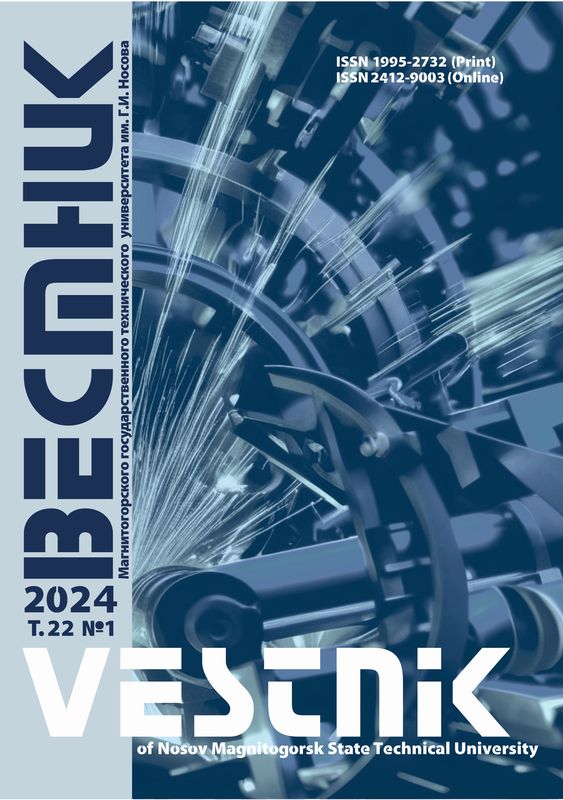DOI: 10.18503/1995-2732-2024-22-1-156-165
Abstract
The presented research paper is a continuation of previously published studies on the basic patterns of behavior of self-interlocking structures under various loading conditions. Finite element computer modeling was used to analyze the stress state of a few of self-interlocking structures made of cubic elements. The SIMULIA Abaqus finite element analysis software package was applied to analyze the ability of self-interlocking structures consisting of several layers to dissipate point and volumetric external loads. The obtained simulation results demonstrated a broad theoretical potential, key applicability limitations, and main stress distribution patterns, when using two- and ten-layer self-interlocking structures. It has been demonstrated that structures of this kind are excellent for dissipating a load distributed over the surface, but they are to be assessed from the perspective of a rational number of layers and elements used, since under loads of a certain value (and at a number of points of their application) individual layers will not be involved in the work, but will lead to an increase in total weight or complication of the design. Based on the modeling results, it was also established that when varying the sizes of elements in individual layers, special attention should be paid to the stability of such structures, since under a number of loading conditions the structure was completely damaged. In particular, the study investigated the case of a two-layer structure with a two-fold difference in the linear dimensions of cubic elements, when load of smaller elements resulted in an uneven distribution of stresses and, as a consequence, complete destruction. The paper presents initial preliminary results of using a sandwich panel manufactured using a self-interlocking structure, which makes it possible to reduce localized values of contact stresses by increasing the area of the contact spot due to internal stress redistribution. The analysis of traces of contact pressure on the panel and on the workpiece deformed with its help showed that pressure applied to the workpiece being deformed was almost half as much, but the contact spot itself was larger and more uniform.
Keywords
multilayer self-interlocking structures, finite element modeling, load redistribution, complex loading, sandwich panels
For citation
Konstantinov D.V., Pivovarova K.G., Pesin A.M. Fem Study on the Stress State of Multilayer Self-Interlocking Structures Made of Cubic Elements. Vestnik Magnitogorskogo Gosudarstvennogo Tekhnicheskogo Universiteta im. G.I. Nosova [Vestnik of Nosov Magnitogorsk State Technical University]. 2024, vol. 22, no. 1, pp. 156-165. https://doi.org/ 10.18503/1995-2732-2024-22-1-156-165
1. Dyskin A.V., Estrin Y., Kanel-Belov A.J., Pasternak E. Toughening by fragmentation – how topology helps. Advanced Engineering Mater. 2001;3:885-888.
2. Dyskin A.V., Estrin Y., Kanel-Belov A.J., Pasternak E. Topological interlocking of platonic solids: A way to new materials and structures. Phil. Mag. Lett. 2003;83:197-203.
3. Dyskin A.V., Estrin Y., Pasternak E., Khor H.C., Kanel-Belov A.J. Fracture resistant structures based on topological interlocking with nonplanar contacts. Advanced Engineering Mater. 2003;5(3):116-119.
4. Kanel-Belov A.J. Interlocking structures. Kvant. Fiziko-matematicheskii zhurnal dlya shkolnikov i studentov [Quantum. Journal of Physics and Mathematics for School and University Students]. 2009;1:20-23. (In Russ.)
5. Dyskin A.V., Estrin Y., Pasternak E., Khor H.C., Kanel-Belov A.J. The principle of topological interlocking in extraterrestrial construction. Acta Astronautica. 2005;57(1):10-21.
6. Estrin Y., Dyskin A.V., Pasternak E., Khor H.C., Kanel-Belov A.J. Topological interlocking of protective tiles for Space Shuttle. Phil. Mag. Letters. 2003;83:351-355.
7. Dyskin A.V., Estrin Y., Kanel-Belov A.J., Pasternak E. Interlocking properties of buckyballs. Physics Letters A. 2003;319:373-378.
8. Djumas L., Simon G.P., Estrin Y. et al. Deformation mechanics of non-planar topologically interlocked assemblies with structural hierarchy and varying geometry. Scientific Reports. 2017;7(1):11844. https://doi.org/10.1038/s41598-017-12147-3.
9. Khandelwal S., Siegmund T., Cipra R.J., Bolton J.S. Transverse loading of cellular topologically interlocked materials. Int. J. Solids Struct. 2012;49(18):2394-2403.
10. Khandelwal S., Cipra R.J., Bolton J.S., Siegmund T. Adaptive mechanical properties of topologically interlocking material systems. Smart Mater. Struct. 2015;24(4):045037.
11. Feng Y., Siegmund T., Habtour E., Riddick J. Impact mechanics of topologically interlocked material assemblies. Intl. J. Impact Eng. 2015;75:140-149.
12. Siegmund T., Barthelat F., Cipra R.J., Habtour E., Riddick J. Manufacture and mechanics of topologically interlocked material assemblies. Applied Mechanics Reviews. 2016;68(4):040803.
13. Mather A., Cipra R.J., Siegmund T. Structural integrity during remanufacture of a topologically interlocked material. Int. J. Struct. Integr. 2012;3(1);61-78.
14. Konstantinov D.V., Matveev S.V., Pesin A.M., Korchunov A.G., Pivovarova K.G. Application of interlocking structures: FEM-based concept demonstration. Vestnik Magnitogorskogo gosudarstvennogo tekhnicheskogo universiteta im. G.I. Nosova [Vestnik of Nosov Magnitogorsk State Technical University]. 2023;21(1):93-99. (In Russ.) https://doi.org/10.18503/ 1995-2732-2023-21-1-93-99












